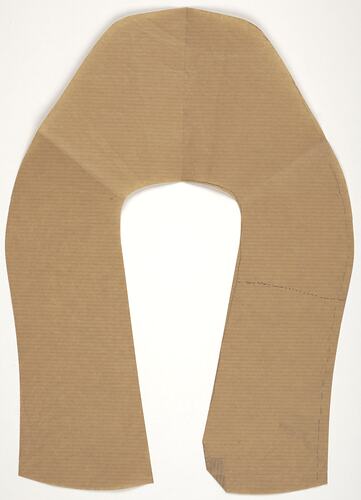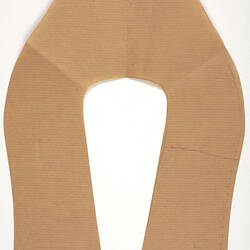Summary
This hand-made shoe pattern piece is generated from brown paper and was most likely used by Stanio Fancoff in the creating of his various shoe styles sometime between the 1930s - 1970s. The pattern's distinct 'U' shape suggests it was a combination of toe, vamp and side shoe covering. Amongst many others, this pattern is part of the shoemaking designer kit that enabled Stanio to acquire versatility and different fashions within his shoemaking trade.
Stanio Ivanoff Fancoff was born in 1908 in Bojentsi, a small village in Bulgaria. At age 11, Stanio left home to learn the shoemaking trade. In 1929, he immigrated to Melbourne, settled in Fitzroy and began to work for the V.G. Zemancheff & Sons basket shoe factory in South Melbourne. In1936, he married Dorotea Georgi Touzou who had recently arrived in Australia. Around this time, Stanio set up his own shoemaking business from home, with Georgi, her cousin and sister weaving the shoes which he then assembled. Select shoe samples were then taken to Sydney and Tasmania for sale. In 1942, Georgi and Stanio moved to Broken Hill for Georgi's health; there daughter Nancy was born and Stanio set up a shoe shop/factory. In 1945, Georgi died and by 1950 Stanio and Nancy had moved to Adelaide where he again opened a shoemaking business and shop. He passed away in 1978, having been in the shoemaking business for 59 years. This collection documents his migration and working life experiences.
Physical Description
Generated from lined brown paper, this stylised 'U' shaped shoe pattern has several pencil and pen markings. A pencil marked line parallels the inner U shape's top edge and follows down the inner right side, while on the outer right edge a dashed line ascends from the base and once hitting curvature it transforms into a consistent line. Furthermore, at the midway point a penned dotted line stems between the outer and inner edges. Although the pattern appears to be in good condition, it has been symetrically folded length ways and folded to make diagonal creases within the top portion. In addition, the lower right inner corner has been folded, possible due to incorrect storage or careless use.
Significance
This collection is significant in documenting a small migrant business as well as the fashion of a particular period. It is well provenanced and charts the application of trade skills in a new country. It also illustrates the stages of hand shoe manufacture from the 1930s, demonstrating the enduring nature of the tools and patterns that were used.
More Information
-
Collecting Areas
-
Acquisition Information
Donation from Nancy Vasileff, 21 Mar 2007
-
Maker
-
Classification
-
Category
-
Discipline
-
Type of item
-
Overall Dimensions
105 mm (Width), 295 mm (Height)
-
References
R.A. Salaman, 'Dictionary of Leather-working Tools c.1700-1950 and Tools of Allied Trades,' London: George Allen and Unwin (Publishers) Ltd, 1986 [Section 2: Boot and Shoe Maker pp18-185]. John Peacock. 'Shoes, The Complete Sourcebook,' London:Thames & Hudson Ltd, 2005. NAA holds file (online) on Vasil George Zemancheff, Fancoff's employer
-
Keywords
Boot & Shoemaking, Bulgarian Communities, Bulgarian Immigration, Immigration, Small Businesses



